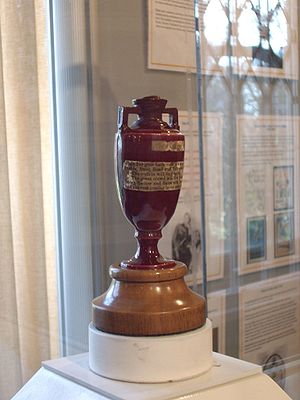
In the world of cricket, few symbols carry the weight of history, passion, and rivalry as the Ashes urn. Originating from a lighthearted obituary notice published in a British newspaper, the urn has become an iconic representation of the Ashes cricket series contested between England and Australia. With its enigmatic origins, rich folklore, and enduring significance, the Ashes urn encapsulates the spirit of one of the most storied and fiercely competitive rivalries in the cricketing world.
Also See: Cricket World Cup Trophies [through all Editions]
A Legendary Origin Story: The story of the Ashes urn dates back to 1882 when Australia registered their first-ever Test victory on English soil at The Oval. This unexpected triumph led to a mock obituary stating that English cricket had died, and “the body will be cremated, and the ashes taken to Australia.” The legendary journalist, Reginald Brooks, even presented a small urn believed to contain the ashes of a burnt cricket ball as a symbolic trophy to the victorious Australian captain, Ivo Bligh. While the actual urn has never been awarded as the official prize, it has since become a treasured symbol of the series.
The Ashes Urn Mythology: Despite its diminutive size—standing at just over six inches tall—the Ashes urn possesses an almost mythical aura. The origin and composition of the ashes within the urn have been subjects of debate and speculation for over a century. While it is widely believed that the ashes were remnants of a cricket ball, some suggest that they might have come from a stump or bails. The exact nature of the ashes continues to be shrouded in mystery, adding to the mystique and allure of the urn.
Symbolism and Significance: The Ashes urn represents far more than a mere trophy. It embodies the deep-rooted cricketing rivalry between England and Australia, reflecting the historic battles, intense competition, and unwavering pride associated with the Ashes series. The significance of the urn lies in the honor bestowed upon the winning team at the end of each series. The victors earn the right to retain the Ashes, while the vanquished team strives to reclaim this prestigious symbol of supremacy in subsequent encounters.
The Ashes Series and the Urn’s Journey: The Ashes series is contested biennially, alternating between England and Australia, and consists of five Test matches. Despite the urn’s cultural significance, it is not physically present during the series. Instead, a replica is used as a ceremonial trophy, while the original urn is securely displayed at the Marylebone Cricket Club (MCC) Museum at Lord’s Cricket Ground in London. The urn is treated with utmost reverence, attracting cricket enthusiasts from around the world to witness this symbol of cricketing history.
Legacy and Cultural Impact: The Ashes urn has transcended its role as a mere cricketing trophy to become an enduring symbol of national pride, camaraderie, and intense sporting rivalry. The series has produced legendary players, unforgettable performances, and captivating narratives that have captured the imagination of cricket fans across generations. The urn’s legacy and cultural impact extend far beyond the cricket pitch, representing the shared heritage and deep-rooted passion for the game between two cricketing powerhouses.
The Ashes urn stands as an everlasting testament to the rich history, fierce competition, and unwavering spirit of the Ashes cricket series. It embodies the essence of cricketing rivalry between England and Australia and symbolizes the pursuit of glory and honor on the hallowed grounds. As cricketing legends are forged, new chapters are written, and the urn passes from one victorious team to another, it serves as a constant reminder of the timeless tradition and enduring legacy of the Ashes series. The Ashes urn’s enigmatic origin, intertwined with folklore and mythology, has only added to its mystique and captivated the imaginations of cricket fans worldwide. As each Ashes series unfolds, the urn remains an ever-present reminder of the historic battles, sporting excellence, and the unyielding determination exhibited by players from both sides.
Beyond its symbolism and significance, the Ashes urn has also become a cultural icon. It has inspired literature, artwork, and even feature films. Its allure has transcended the boundaries of cricket, captivating the attention of sports enthusiasts and historians alike. The story of the urn has been immortalized in countless tales and has become an integral part of cricketing folklore, passed down through generations, ensuring its place in sporting legend.
The Ashes series, with its fierce competition and unparalleled intensity, has consistently produced some of the most iconic moments in cricketing history. From thrilling comebacks to legendary performances, the battles for the urn have etched themselves into the collective memory of cricket fans. The urn’s presence at the MCC Museum in Lord’s Cricket Ground is a testament to the reverence with which it is held and the legacy it represents.
As cricket enthusiasts eagerly anticipate each Ashes series, the desire to witness the urn change hands drives the intensity and passion of the contest. The fierce rivalry between England and Australia adds an extra layer of significance to each match, as players vie not only for victory but also for the honor of holding the Ashes urn aloft.
In conclusion, the Ashes urn stands as a timeless symbol of cricketing legacy and rivalry. Its origin and mythology, coupled with its enduring significance, have made it an iconic representation of the Ashes cricket series. As the urn continues to inspire generations of cricket lovers, its presence reminds us of the rich history, fierce competition, and unwavering passion that defines the Ashes series. With each new chapter written in the annals of cricket, the Ashes urn remains an everlasting testament to the enduring spirit of the game.
Also Read:
- IND vs ENG: Jadeja, Sundar, Gill Hundreds Help India Earn Dramatic Draw Against England in 4th Test
- “If There Are No Bilateral Matches, Why Play in Multination Events?”: Azharuddin on India-Pakistan Asia Cup Clash
- Men’s Asia Cup 2025 To Be Held In UAE; ACC
- Ben Stokes Creates History With 11,000 International Runs And Rare 7,000 Runs-200 Wickets Test Feat




